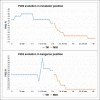Feasibility of three-dimensional nasal imaging and printing in producing customized nasal masks for non-invasive ventilation in extremely low birth weight infant: A pilot study
- PMID: 36844248
- PMCID: PMC9947380
- DOI: 10.18063/ijb.v9i1.627
Feasibility of three-dimensional nasal imaging and printing in producing customized nasal masks for non-invasive ventilation in extremely low birth weight infant: A pilot study
Abstract
72Several studies have been conducted to investigate the feasibility of customized nasal masks produced by three-dimensional (3D) facial imaging and printing for continuous positive airway pressure in adults and in premature mannequin. In addition to replicating the entire process, we applied the customized nasal mask to a premature patient who weighed less than 1,000 g. Facial scanning was performed. The study masks were manufactured using stereolithography with a 3D printer model Form3BL (FormLABS). Elastic 50 resin was used as the material. We verified the feasibility of the correct transmission of non-invasive ventilation and found that the mask improved the respiratory parameters and reduced the need for supplemental oxygen. The fraction of inspired oxygen (FiO2) was lowered from 45%, which was the requirement when the traditional mask is used, to almost 21% when the nasal mask was applied to the premature patient, who was either in incubator or in kangaroo position. In view of these results, a clinical trial is being launched to evaluate the safety and efficacy of 3D-printed masks in extremely low birth weight (ELBW) infants. 3D printing provides an alternative for obtaining customized masks that may be more suitable for non-invasive ventilation in ELBW infants than traditional masks.
Keywords: Child health; Intensive care units; Neonatal; Neonatology; Technology and therapeutics.
Copyright: © 2022 Martín-Gónzález et al.
Conflict of interest statement
All authors declare no conflicts of interests.
Figures





References
-
- Duong K, Glover J, Perry AC, et al. Feasibility of three-dimensional facial imaging and printing for producing customised nasal masks for continuous positive airway pressure. ERJ Open Res . 2021;7(1):00632–2020. https://doi.org/10.1183/23120541.00632-2020. - PMC - PubMed
-
- Shikama M, Nakagami G, Noguchi H, et al. Development of personalized fitting device with 3-dimensional solution for prevention of NIV oronasal mask-related pressure ulcers. Respir Care . 2018;63(8):1024–1032. https://doi.org/10.4187/respcare.05691. - PubMed
-
- Zheng J, He H, Kuang W, et al. Presurgical nasoalveolar molding with 3D printing for a patient with unilateral cleft lip, alveolus, and palate. Am J Orthod Dentofacial Orthop . 2019;156(3):412–419. https://doi.org/10.1016/j.ajodo.2018.04.031. - PubMed
-
- Hadeed K, Dulac Y, Acar P. Three-dimensional printing of a complex CHD to plan surgical repair. Cardiol Young . 2016;26(7):1432–1434. https://doi.org/10.1017/S1047951116000755. - PubMed
-
- Xu JJ, Luo YJ, Wang JH, et al. Patient-specific three-dimensional printed heart models benefit preoperative planning for complex congenital heart disease. World J Pediatr . 2019;15(3):246–254. https://doi.org/10.1007/s12519-019-00228-4. - PubMed
LinkOut - more resources
Full Text Sources
